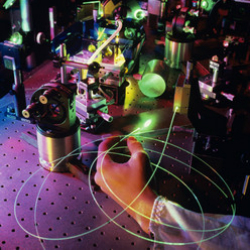Training network on fibre lasers
Bringing together three universities and three academic institutions from the EU and Russia, RANDFIELDS (Random fibre lasers for telecommunications and distributed sensing) set the stage for groundbreaking applications in optical telecommunications and sensing. Project members demonstrated random distributed feedback Raman fibre lasers operating at different regimes such as tunable, narrow-band, multi-wavelength and pulsed. Implementation of new numerical models helped describe different types of fibre lasers. Beyond the Raman one, the project team has developed the theoretical background for the random Brillouin fibre laser. In addition, it studied different properties of random generation, (statistical, noise and spectral) in various random lasers operating via different mechanisms (Brillouin and Raman). The team also explored dynamical wave kinetics of laser systems. Project scientists proposed new ways of generating multi-wavelength and pulsed distributed feedback Raman fibre lasers that can reach ultimate quantum efficiency. They designed and tested new types of fibres (multi-core, tapered, W-shaped and with enhanced Rayleigh scattering), including those for mode-locked operation, in various applications. Advanced knowledge transfer took place at a summer school on advances in optical technologies and at a winter school on optical wave turbulence. RANDFIELDS also organised several workshops on different topics. These included random fibre lasers, non-linear spectral broadening in fibre lasers, disorder and wave turbulence, advanced numerical modelling of fibre lasers and fibre systems. Knowledge transfer between Europe and Russia was the main topic of two other workshops. In addition to these activities, the team organised a number of lectures and seminars. The project's knowledge transfer and networking activities proved very successful and resulted in new joint projects. Project research results have been published in peer-reviewed journals and a book.







